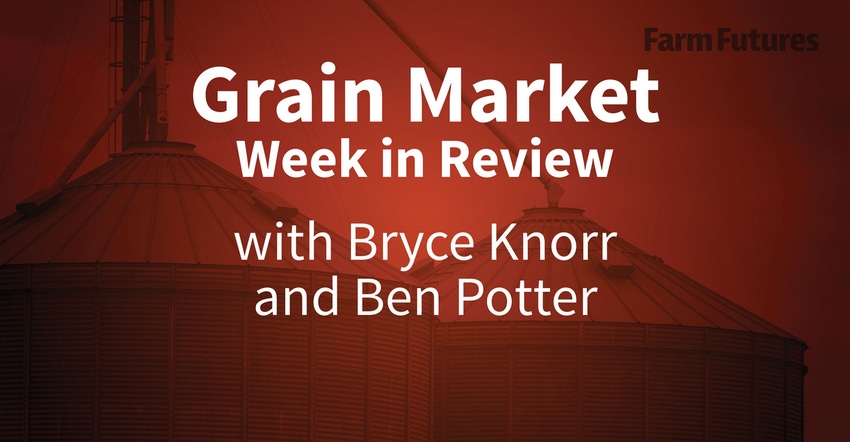June 28, 2019

Missed some market news this week? Here’s what Bryce Knorr and Ben Potter have been writing about this week.
Audio
A lower open across the board Sunday night didn’t last long as selling quickly dried up at the start of a crucial week for the grain market. This afternoon’s crop progress reports will show whether farmers planted any more corn last week, with USDA updating its estimate for acreage on Friday. The trade war between the U.S. and China also faces a test later in the week at the G-20 summit in Japan, where President Trump and President Xi of China are set to meet.
There’s plenty of things for investors on Wall Street to worry about right now, from tensions with Iran to the upcoming G-20 summit. But grain traders are focused on one thing as usual during the summer: weather. Monday’s progress report from USDA showed crops suffering from too much rain, though conditions reflect a tale of two Corn Belts. Fields improved in the west but declined sharply east of the Mississippi River, which is closed again due to high water in St. Louis.
Temperatures could top 100 degrees over the weekend in parts of the western Corn Belt, but that’s not the heat traders are waiting for. USDA releases crucial acreage and stocks data Friday followed by the long-awaited meeting between President Trump and President Xi of China at the G-20 summit Saturday.
Markets are quiet overnight, a situation that may not last once USDA releases highly anticipated reports at 11 a.m. CDT. While June 1 Grain Stocks can sometimes surprise, all eyes will be on the agency’s acreage estimates after a historically wet spring disrupted the planting season. Other markets are also wary as trade negotiators from the U.S. and China talk at the G-20 summit, with President Trump and President Xi scheduled to meet tomorrow.
Crop progress
USDA is typically done reporting corn planting progress by late June, but this spring’s set of unusually wet circumstances has the agency still reporting those numbers for the week ending June 23. Other highlights of this week’s report include soybean planting progress, corn and soybean crop quality, and winter wheat harvest progress.
Outlooks
Basis outlook - The Upper Mississippi River is finally open for business. Some 15 tows moved upriver north of St. Louis in the first 24 hours after the harbor in St. Louis was given a green flag to reopen. While seven tugs moved down river towards St. Louis they carried few barges, and will instead be putting together tows. Northbound locking was permitted to get going first get the flow of grain going again towards the Gulf. High water is expected to limit tow sizes.
Energy/Ethanol Outlook - Price targets and seasonal trends aren’t only for grain marketing. They can also be useful when it comes to buying volatile energy inputs for the farm. Farmers may think the grain market is volatile. But crude oil fluctuations can be even more intense.
Financial outlook - The refusal of the Federal Reserve to cut interest rates this year triggered the ire of President Trump, who says the central bank’s tightening last year was a mistake. But the president may get his way soon, perhaps at the end of the Fed’s two-day meeting on monetary policy July 31.
Fertilizer outlook - After a disastrous fall and spring application season, fertilizer may be the last topic growers want to think about. But it’s time to get serious about booking supplies for 2020, when prices could be higher if corn acres expand as expected.
Feedback
Farmers reporting Feedback From The Field last week made only incremental progress, raising their corn planting estimates to 94%. Most have long given up planting, switching to soybeans or, more likely, taking prevent plant coverage from crop insurance policies. Growers said they made some headway with soybean planting.
Acreage report
Planted corn acres this year are expected to reach 91.7 million acres, according to USDA. That tally is 3% higher than 2018’s total. Expected harvested acres are moderately lower, at 83.6 million acres, but still 2% above last year. USDA’s assessment for 2019/20 all-wheat U.S. acres declined slightly, to 45.6 million acres after the agency increased estimates for winter wheat acres but lowered estimates for spring wheat acres. USDA pegged 2019 U.S. soybean acres well below analyst expectations, with a total of 80.4 million acres.
Exports
Even though total grain export inspections for corn, soybeans and wheat fell shy of weekly rates needed to reach USDA marketing year forecasts, there were some bright spots for the week ending June 20, according to Farm Futures senior grain market analyst Bryce Knorr.
USDA had a mixed bag of export sales data in its latest weekly report, out Thursday morning. Wheat saw the most upside last week, according to Farm Futures senior grain market analyst Bryce Knorr.
Two large export sales of soybeans were reported this week. China took nearly 20 million bushels and unknown destinations took 5.3 million bushels.
Recaps
Grain futures are narrowly mixed today as the market counts down to USDA grain stocks and acreage reports due at 11 a.m. CDT. While the estimates of plantings won’t be the last word on the subject they should dominate the discussion until more is known about yield potential.
USDA’s highly anticipated acreage report, out Friday morning, shocked grain prices in today’s session. Corn and wheat saw major cuts based on the agency’s latest numbers, which had corn acreage significantly higher than anticipated. Soybean acres fell lower than analyst expectations, meantime, helping push prices nearly 1.5% higher.
About the Author(s)
You May Also Like




